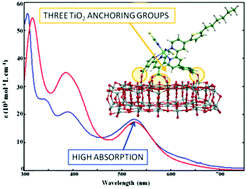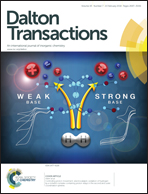Engineering of Ru(ii) dyes for interfacial and light-harvesting optimization†
Abstract
A new Ru(II) dye, Ru(L1)(L2) (NCS)2, L1 = (4-(5-hexylthiophen-2-yl)-4′(4-carboxyl-phenyl 2,2′-bipyridine) and L2 = (4-4′-dicarboxy-2,2′-bipyridine), labelled MC112, based on a dissymmetric bipyridine ligand for improved interfacial and optical properties, was synthesized and used in DSCs, yielding photovoltaic efficiencies of 7.6% under standard AM 1.5 sunlight and an excellent device stability. Increased light harvesting and IPCE maximum were observed with MC112 compared to the prototypical homoleptic N719 dye, due to the functionalized bipyridyne ligand acting as an antenna. In addition, the mixed bipyridyne ligand allowed MC112 binding to TiO2 to occur via three anchoring carboxylic groups, thus exhibiting similar interfacial properties to those of the N719 dye. DFT/TDDFT calculations were performed on the new dye, both in solution and adsorbed on a TiO2 surface model, revealing that the peculiar photovoltaic properties of the MC112 dye are related to its anchoring mode. The new design rule thus allows us to engineer both light-harvesting and interfacial properties in the same dye.


 Please wait while we load your content...
Please wait while we load your content...